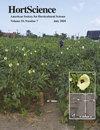细胞分裂素 B-Mo 类产品的施用时机影响鹅掌楸(Plectranthus scutellarioides cv. Wild Lime)不定根发育过程中的扦插生根特征和非结构性碳水化合物
IF 1.5
3区 农林科学
Q2 HORTICULTURE
引用次数: 0
摘要
许多园艺物种都是通过从原种植株上扦插枝梢并种植形成不定根进行无性繁殖的。不定根导致在根系再生区域建立一个高度依赖能量和碳骨架的碳水化合物汇。我们假设,在不定根发育过程中外源施用细胞分裂素(CK)和硼(B)-钼(Mo)基产品的时间会影响糖从叶片流向吸收汇、不定根的碳分配以及扦插生根的质量。在该项目中,我们旨在确定在未生根插条的不定根发育期间施用 CK/B-Mo 类产品的时间是否会影响源到汇的关系,进而影响插条的生长和质量。在插条生长的四个阶段施用一种基于细胞分裂素、硼和钼的沉降强化商业产品,外加一个阴性对照,具体如下:T1,未施用产品的植株(对照);T2,插条阶段(插条后 24 小时开始);T3,茧形成阶段;T4,根系发育阶段;T5,调色阶段。测量了根和芽的长度和干物质、叶片数量、叶绿素含量、根与芽的比率(基于干物质)以及非结构性碳水化合物的含量。施用产品的时间对根系发育、插条质量和非结构性碳水化合物含量都有影响。在不定根脱分化和诱导阶段(T2)施用产品会导致根和芽的长度最短、干物质积累最少、非结构性碳水化合物含量最低以及一些植物毒性。与对照组相比,在起始阶段(T3)施用会使根长、总干物质和总可溶性糖含量增加。在表达期(T4)施用,根的长度和质量最大,蔗糖含量最高。与对照组相比,在根系生长到生长介质的所有边缘时施用该产品(T5)没有任何益处。这项研究提供了关于外源 CKs、B 和 Mo 的应用时机的新见解,以生成根系发达的鹅掌楸切片,并提供了与非结构性碳水化合物代谢有关的潜在解释。本文章由计算机程序翻译,如有差异,请以英文原文为准。
The Application Timing of a Cytokinin B-Mo-based Product Affects the Characteristics of Rooted Cuttings and Nonstructural Carbohydrates of Coleus (Plectranthus scutellarioides cv. Wild Lime) during Adventitious Root Development
A large group of horticulture species are propagated vegetatively through shoot-tip cuttings harvested from stock plants and planted to form adventitious roots. Adventitious rooting leads to establishing a carbohydrate sink in the region of root regeneration that is highly dependent on energy and carbon skeletons. We hypothesized that the timing of exogenous applications of cytokinin (CK) and boron (B)–molybdenum (Mo)-based products during adventitious root development can affect the flow of sugars from leaves to sinks, carbon allocation to the adventitious roots, and the quality of rooted cuttings. During this project, we aimed to determine if the application time of a CK/B-Mo-based product during the adventitious root development of unrooted cuttings would impact the source-to-sink relationship and, hence, affect plug growth and quality. A sink-strengthening commercial product based on cytokinin, B, and Mo was applied at four plug development stages plus a negative control as follows: T1, plants without product (control); T2, sticking stage (starting 24 hours after the sticking); T3, callus formation stage; T4, root development stage; and T5, toning stage. The root and shoot lengths and dry matter, number of leaves, leaf chlorophyll content, root-to-shoot ratio (based on dry matter), and nonstructural carbohydrate contents were measured. The timing of the application of the product impacted the root development, quality of the cuttings, and nonstructural carbohydrate content. Product application during the adventitious root dedifferentiation and induction phases (T2) resulted in the shortest root and shoot lengths, lowest dry matter accumulation, lowest nonstructural carbohydrate contents, and some phytotoxicity. Application during the initiation phase (T3) resulted in greater root length, total dry matter, and total soluble sugar contents compared with the control. Application during the expression phase (T4) resulted in the largest root length and mass and the highest sucrose contents. Applying the product when the roots had grown and reached all the edges of the growing media (T5) did not have any benefits compared with the control. This study provides new insights into the application timing of exogenous CKs, B, and Mo to generate a well-toned rooted coleus cutting and potential explanations in relation to nonstructural carbohydrate metabolism.
求助全文
通过发布文献求助,成功后即可免费获取论文全文。
去求助
来源期刊

Hortscience
农林科学-园艺
CiteScore
3.00
自引率
10.50%
发文量
224
审稿时长
3 months
期刊介绍:
HortScience publishes horticultural information of interest to a broad array of horticulturists. Its goals are to apprise horticultural scientists and others interested in horticulture of scientific and industry developments and of significant research, education, or extension findings or methods.
 求助内容:
求助内容: 应助结果提醒方式:
应助结果提醒方式:


